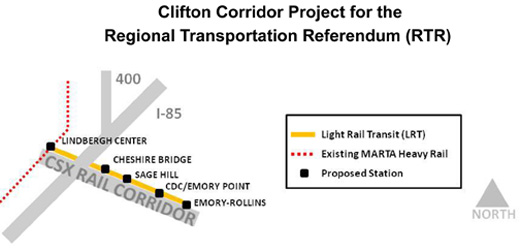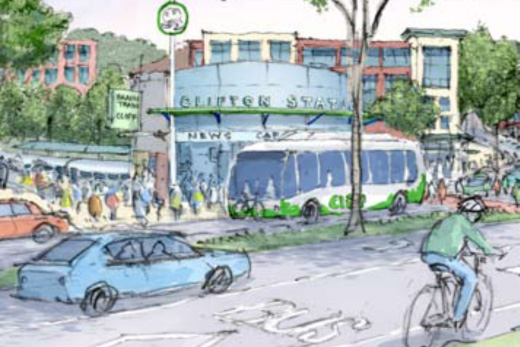Imagine stepping aboard a light rail train at the Lindbergh MARTA station and gliding straight into the heart of the Emory campus.
The impact? That 13-minute trip could allow riders to bypass early-morning gridlock, avoid parking hassles and help thin traffic congestion along Clifton Road — DeKalb County’s largest employment center — while reducing air pollutants for pedestrians, bikers and auto commuters alike.
For now, the scenario is a futuristic vision. But supporters of the upcoming regional transportation referendum (also known as the Transportation Investment Act or TSPLOST) insist that vision is not only viable, but a rare opportunity finally within reach for the campus community.
Their position: Voting on July 31 to approve a proposed 1 percent sales tax would raise funds to bring much-needed light rail service — and other improvements — to the traffic-clogged Clifton Corridor and beyond.
If approved, the penny tax would raise an estimated $7.2 billion over 10 years to fund 157 regional transportation projects across 10 metro Atlanta counties — the largest single infrastructure investment in the region’s history, advocates assert.
While 85 percent of those funds, around $6 billion, would support large regional transportation projects — from highway interchanges to new train lines —15 percent, about $1 billion over a decade, would underwrite smaller, local transportation projects to be chosen by counties and municipalities.
In DeKalb County, those projects have not been specified, though CEO Burrell Ellis has said he anticipates some will support road resurfacing and building sidewalks and bike paths.
Polls and projections suggest the referendum vote will be close. Though supported by many Georgia leaders — from Republican Gov. Nathan Deal to Atlanta Mayor Kasim Reed — the measure also faces diverse opposition, including tax-leery voters, Tea Party activists and the Sierra Club, which supports greater mass transit expansion and improvements.
What’s in it for Emory?
Three projects would directly serve employees of Emory and its Clifton Corridor neighbors, including the U.S. Centers for Disease Control and Prevention (CDC) and Children’s Healthcare of Atlanta:
- Construction of a light rail line from the Lindbergh Center MARTA station to Emory.
- Replacement of the Clifton Road bridge; improvements to Haygood Road.
- Bike and pedestrian improvements between Decatur and the Clifton Corridor.
The most visible impact would be creation of a light rail line serving the Emory campus and Clifton Corridor, the largest employment center in metro Atlanta without direct access to an interstate or rail service, according to Atlanta’s Regional Commission (ARC).

The first phase of a proposed light rail line would connect the Lindbergh Center MARTA station and the Emory campus. Courtesy of MARTA.
The $700 million slated for light rail development could also be used as local matching funds to help leverage additional federal money to extend the line from Emory to Avondale, says Betty Willis, Emory’s senior associate vice president for governmental and community affairs.
Though environmental impact, preliminary design and engineering studies haven’t begun, Willis notes that several studies have been completed in the last two years, including a feasibility plan and Local Preferred Alternative (LPA) processes. The LPA process drew upon community stakeholders for planning routes, types of transit, and the likely locations of rail stops/stations. While exact locations will be decided in the next study phase, four stops are planned: the Cheshire Bridge Road area, at the Sage Hill shopping center, near the CDC/Emory Point area, and the Rollins School of Public Health. The plan is to extend the rail line to the Clairmont Campus and on to the Avondale station with additional federal funds.
"The reality is, we are going to be voting on a concept of connecting the Clifton Corridor to Lindbergh MARTA station without every bit of that path being well defined," acknowledges Ciannat Howett, Emory’s director of sustainability initiatives.
Based upon current discussions, Willis says portions of light rail may be routed directly onto Clifton Road, which now carries in excess of 23,000 vehicles a day, according to a 2010 traffic study. Light rail trains are typically powered by overhead cables; some tunnels and aerial structures would be used to reduce residential impact and to negotiate elevated or complicated terrain, according to Willis.
Once operational, an ARC study projects that the light rail line could support an average of 10,200 daily weekday boardings, says Mike Alexander, ARC research division chief. If approved, construction would begin around 2018, with completion slated for 2021.
ARC studies show that could have a significant impact on both car and rail commute times for Clifton Corridor workers: 700 percent more commuters — about 223,000 — would be able to get to Emory by bus or rail within 45 minutes and 6 percent more —about 22,200 — would be able to reach Emory by automobile in 45 minutes or less.
Bike, pedestrian, roadway improvements
Along with plans to rebuild and expand the aging Clifton Road bridge, which crosses over the CSX Railroad, the measure would fund installation of sidewalks and bike lanes and resurfacing along Haygood Road, between North Decatur and Clifton roads, to help ease congestion and traffic flow, Willis explains.
Additionally, bike, pedestrian and road improvements would be funded between Decatur and the Clifton Corridor — including Commerce Drive and Clairemont Avenue.
Together, the projects would go far toward improving transit options, reducing traffic and congestion, improving air quality, and promoting a culture of sustainability, says Howett.
Atlanta traffic ranks as some of the worst in the nation, accounting for more than half of the region’s ozone-forming emissions, according to Georgia’s Environmental Protection Division.
With voter approval, the new transportation projects could help reduce vehicle emissions by 1.2 million fewer pounds of daily tailpipe pollution by 2025 — the impact of removing 72,000 cars off the road each day, according to ARC studies.
"One of the things people who don’t take public transit or ever feel they would use light rail — those dedicated drivers — should realize is that if the referendum passes, they’re also going to see the benefit of decreased traffic congestion," Howett says.
Light rail service could also help the Clifton Corridor grow as a major research artery — such as Route 128 in Boston — where biotech firms and ancillary businesses have developed naturally along established transit routes.
"If scientists and researchers are able to move easily and connect with colleagues at other universities in the area, it would also increase the potential for more research collaboration," Willis notes.
Given the current economy, Howett feels it is "unlikely that we’re going to see another opportunity like this in our lifetime to address Atlanta’s transportation and air quality issues, which really go hand-in-hand."
"That’s a part of this that Emory can speak to uniquely: We’re a major public health institution and the largest health care provider in the state. The public health benefits of seeing these alternatives are enormously important," she says.

